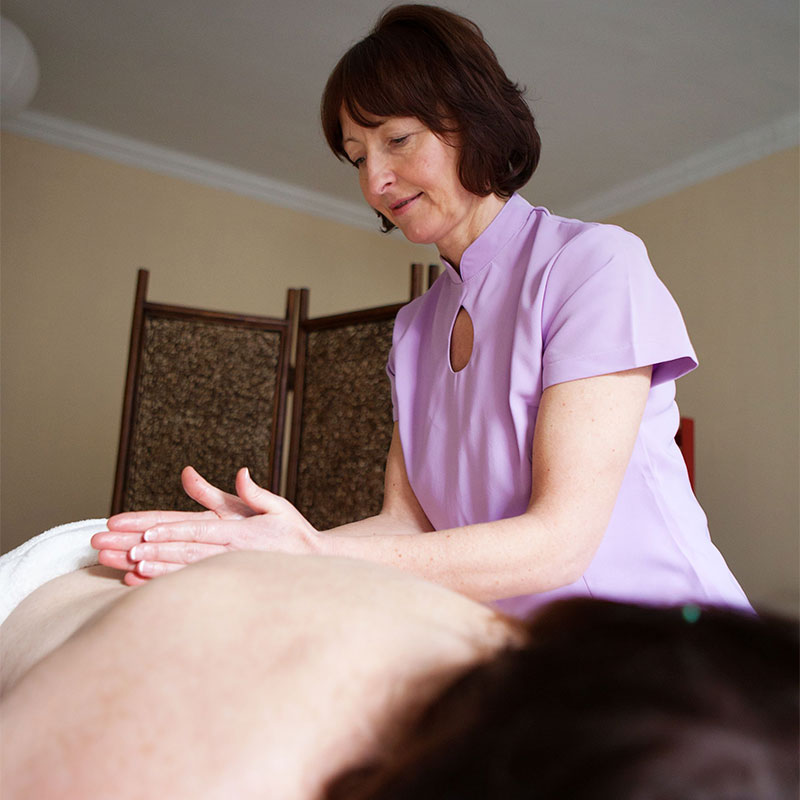Chronic Pain
Over the last twenty years in her private practice as a holistic complementary therapist treating clients in pain, Tina has integrated a number of related therapeutic techniques. Together, these enable her to assess underlying causes of chronic pain or discomfort (neck, shoulder, back, head, TMJ, etc.) and help clients resolve them more rapidly than with the use of a single approach. Tina also uses her Alexander Technique training to help clients address postural alignment problems that may be causing discomfort, and she integrates specific Yoga exercises into client sessions when they are called for. Where appropriate for the relief of a person’s pain, she brings meditation and breath awareness training into sessions, to enhance overall relaxation and heighten self-awareness. She also uses her Craniosacral therapy training to help clients to release suppressed emotions and trauma. She has completed post grad training in trauma informed practices with Peter Levine and Babette Rothchild.
The Alexander Technique is a movement therapy that helps clients both reduce pain, improve alignment and enhance overall performance as they learn how to become aware of and release subliminal tension. Widely used as a teaching tool for actors and musicians, it is equally well known for its ability to help people suffering from pain to recognize and eliminate the bodily habits that underlie their pain, and the presence of which may inhibit their ability to heal fully through other therapies or forms of exercise.
Craniosacral Therapy is a powerful yet gentle hands-on therapy unique in its ability to both effectively get to the root of and treat the underlying causes of pain and discomfort. Integrating extensive anatomical knowledge with a subtle listening touch while at the same time allowing the client’s system to guide the session, craniosacral therapy works primarily with the musculo-skeletal and neurological systems. It is a therapy of choice not only for all forms of back pain, but also for headaches, TMJ, fibromyalgia, chronic fatigue, sinus problems and more. Finally, because illness and pain can be associated with emotional overload and trauma, Craniosacral therapy, through its somato-emotional release dynamic, can provide crucial assistance in accessing and resolving unacknowledged needs and feelings that may contribute to discomfort. Craniosacral Therapy sessions are very relaxing, and generally last up to an hour.
Somato-emotional Release refers to the experience of spontaneous, unforced releasing of suppressed emotions, an experience that can sometimes happen in the course of a Craniosacral Therapy session. This release is a natural consequence of the relaxation induced by Craniosacral Therapy, since withheld and unrecognized feelings tend to be buried in the body’s tissues. When clients become aware of and release deep-seated emotions in the safe and supportive environment of a Craniosacral Therapy session, this can have a profoundly beneficial impact on their lives. Most of us have had experiences of suddenly realizing what is ‘really’ bothering us. Similarly, many of us can go for prolonged periods of time unable to recognize what is bothering us. Instead, we just feel poorly, stressed or sick. When a person experiencing stress or discomfort is able in the process of Craniosacral Therapy to recognize and ‘admit’ what is really the matter for them, they can move on to creative life-affirming solutions. Similarly, since unacknowledged emotions can contribute to somatic illness or pain, somato-emotional release can result in dramatic improvements in health and well-being.
Yoga exercises can act as a powerful tool for healing, particularly when they are selected and taught in a way that addresses specific imbalances involved in a client’s discomfort. Identifying which exercises can be most helpful, and how they should be performed, depends on the therapist’s overall skill in diagnosing the underlying source of discomfort, especially since the location of pain (e.g. in the knee or lower back) may be far removed from its actual cause (e.g. in hip or neck constriction). Tina integrates her decades-long practice of diagnosing the causes of pain with her knowledge as a Yoga practitioner and teacher, to identify the best exercises for clients to move forward in their healing.
